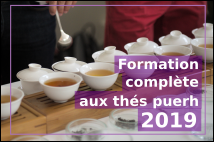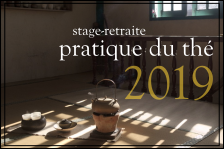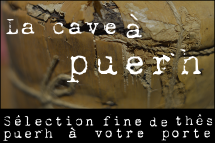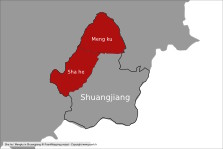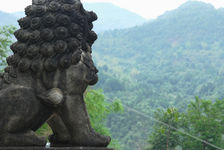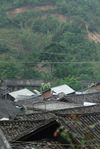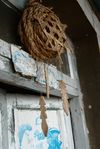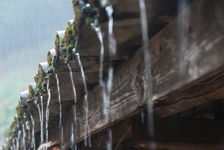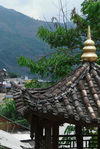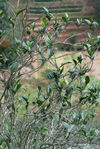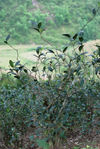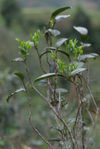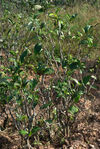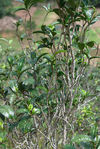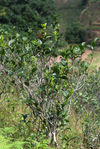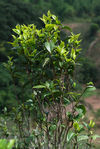 This page is not a real translation but just an automatic translation generated by computer of the original article, written in French language! Its not good... but better than nothing!
This page is not a real translation but just an automatic translation generated by computer of the original article, written in French language! Its not good... but better than nothing!Want to help us do diffuse puerh tea culture in english, by providing a better (or corrected) translation?
Please contact us!

The count ( Xian) Shuangjiang (双 江) is a major production area puerh (Pu Er tea) Lincang . It is home to the township Mengku the North, whose teas are particularly recognized and includes towns like Bing Dao , among the most famous Yunnan .
The village of Da Bang Xie (邦 协) , and the group of village Bang Xie, are not strictly located in the canton of Mengku , but just on the fringe of the latter in the canton of Sha He (沙河) lesser known tea lovers . Attached as entire western half Mengku ( Ban Dong Shan ) on the eastern flank of the ridge Liang Da - Da Xue , Xie Bang is just south of Bang Gay , the last village bordering Mengku .
A ridge separates the two villages of Bang Bang Gay and Xie . To cross from Bang Gay no road but a small path that winds through the trees. Banggai must first back up the ridge to the village Yizhai where a steep path back down the mountain to go back to 1700 mêtres towards Jiulong .


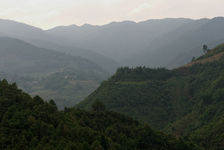
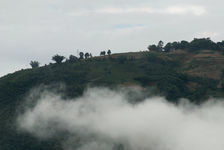
- 1.For allentours Bang Xie
- 2. For allentours Bang Xie
- 3.At allentours Bang Xie
- 4.In allentours Bang Xie
The last peak we perceive the first houses of Jiulong village perched between Mengku and Shahe and off against the bottom appears the hill on which is perched Bang Xie . A beautiful ridge path then slides down the mountain and leads to the village of Xiao Meng'e .
As and when the work can be seen more precisely the area of Sha He. Arriving at the village of Xiao Meng'e , about 1600m altitude we see finally below the side opposite the village of Bang Xie . A mountainside , the village is situated in a fold of the mountain taking the appearance of a tiny bowl.
For ' to get there we must again down the mountain on which we are to face up the steep slope that leads us to Bangxie . As as we approach the village felt his situation, curled like an animal in a tight folds of the mountains.
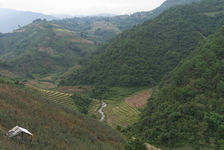
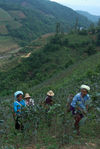
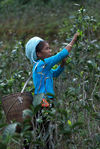
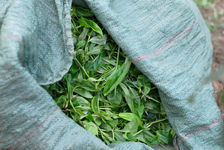
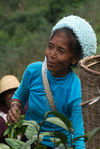
- 1.Arrive Bang Xie by tea plants
- 2.tea pickers Blang Bang Xie
- 3. tea pickers Blang Bang Xie
- 4.Tea leaves freshly picked Xie Bang
- 5.tea pickers Blang Bang Xie
It is surrounded by tea plantations as one enters the village , passing through beautiful green gardens with rich and mellow soil. Around the thin branches of the tea bushes typical profiles Bang Xie and some villages Mengku , rise into the sky like a multitude of outstretched arms. Here and there our gaze can come across women wearing traditional headdress Blang , stretched out their legs to pick tea leaves in the treetops . These gardens a path large partially covered with earth stone street acts and climbed the slope on which the village is built . On either side of this road stood little houses with earthen walls and roofs of old tiles.
Despite its isolation, partially offset by a new road which joins the axis Shuangjiang - Mengku , and the simplicity of its homes, Xie Bang is a large village , or 130 families live exclusively presques Blang ( Wu in their language in the region), a Race living in the area since at least 5000 years .
Bang Xie, a village of Blang tea and culture
Xie Da Bang , as the village of Nong Gong a little further north, are old Blang villages that have a very long history. Before the Western Han Dynasty ( Xi Han ) , and well before the Chinese Yunnan is a region, the Shuangjiang belonged indeed to the former kingdom Ailao , particularly economically and culturally rich kingdom dating back to the period Warring , There are 25 centuries ago . This kingdom was composed mainly by ethnic Pu, from which flows the current Blang , who inhabit the region for over 5000 years .
The most beautiful rest of the distant past is the mountain on which relies Da Bang Xie including many huge trees and wild teas have their drill saw the rise and fall of the United Ailao . Called Da Liang Shan in Chinese , the name of this mountain we return the kingdom of Ailao Blang . Transcribed in Chinese characters today that name is indeed not the Chinese language but the Blang , Liang Shan in that language meaning " mountain ."
It is against by little trace of what life was like in Da Bang Xie in the distant past , if not the vibrant culture that still bathes the Blang village with a rich and astonishing vitality. Like all villages Blang village is dominated by a sacred grove dedicated to the gods Long, that we respect and revere . Similarly, the village is the village life is built around three core areas of Blang village space where people live , or that people work, and finally the places where the dead rest.
Xie Bang life is simple and quiet , work the land and tea are still punctuated by many traditional rituals and festivities. Besides the three great moments of life Blang , birth , marriage and death, which serve all special celebrations , life revolves around different special moment , honoring the ancestors or spirits of the different beliefs Blang .
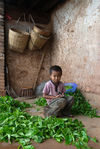
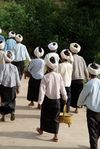
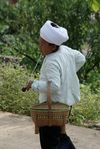
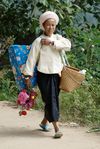
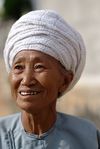
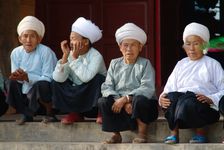
- 1.Daily Life in Bang Xie
- 2. elderly women on their way to temple Bang Xie
- 4. elderly women on the way to the temple Xie Bang
- 5.Women Blang Bang Xie
- 6.Women in the temple of Blang Bang Xie
For example There's a particularly beautiful time in which all older women villages , and they alone , took possession of the temple. During this period, every day at the end of the day, a long colorful procession through the streets of the villages. These are the oldest in the village on their backs food water and blankets that go to the temple . She will spend the night, to meditate, to share this special moment together , eat and sleep in the privacy of the temple before returning to the field in the morning, work the land and harvest the young leaves of tea, then find themselves again between the walls of the temple.
But the most important time of the year is the festival of flower tea , which is the water festival and serves Dai New Year . Several days and the sacred drum rhytme the whole village turns into a bunch of colors and fragrances . Large and small, men and women , each comes alive his best traditional dress for being on the forecourt of the temple.
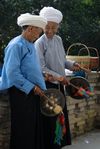
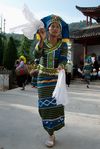
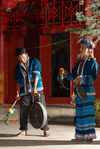
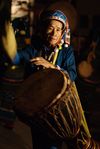
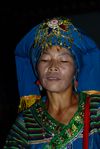
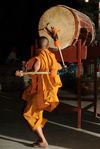
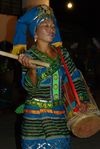
- 1. Blang Bloomfest tea Bang Xie
- 4. Blang Bloomfest Xie Bang tea
- 5. Blang Bloomfest tea Bang Xie
- 6.Blang Bloomfest tea Bang Xie
- 7. Blang Bloomfest tea Bang Xie
And then to the heart of the night drums vibrate . The sacred drum first temple Argue shots unleashed a jovial monk , then those villagers and village , that circle endlessly repeat the ancestral dances not Blang . Although this is the same body, the same faces as we could cross a few hours earlier from the tea bushes in the village , looks and faces change , sparks, magnified by the beauty of the costumes and the magical atmosphere filled the temple, and express the beauty that words can not transcribe .
Although the tea, but also honey, are also at the center of the festivities. Whether to accommodate a friend or a stranger, to celebrate a wedding or special event, or simply accompany the meal , a special place is given to tea. Depending on the situation that is traditionally roasted in a stove or a small metal container in the ground before being served ( KaoCha 烤 茶) , fitted in a section of fresh bamboo ( QinZuCha 青竹 茶), or fermented for several months in a hole dug in the ground ( SuanCha 酸 茶) . Honey is also important for Blang , each house has its hive or , consuming honey infused in hot water as tea.
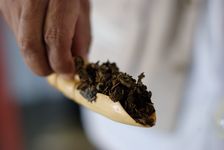
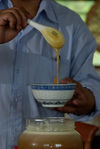
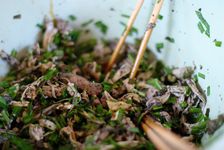
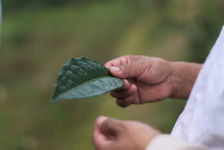
- 1.Suan Cha, traditional tea Blang , Xie Bang
- 2.Honey used to accommodate the guest Xie Bang
- 3.Chicken Blang sour tea , cooked Xie Bang
- 4.Large sheets tea Bang Xie
It is this ancient attraction of Blang for what tea from the gradual domestication of the tea plant , the control of reproduction , size and the art of working the leaves to make tea , and it is the Blang that is attributed one of the oldest gardens in Yunnan tea . The oldest , as we can see in Blang Shan in Xishuangbanna and back more than 1000 years.
In the past there was next to Bang Wa Xie a town , another ethnic particularly present in the region, where a hundred families lived . The latter having moved to Cang Yuan at the end of the reign of Guang Xu ( late 19th ) , no one can say whether the ancient trees around the village are the result of Blang or Wa .
In the 14th century Dai , from Meng Mao (now called Rui Li, in the De Hong ) took power in the region and build their government Shuangjiang . From then until 1930 the Blang Bang Xie and throughout the region came under the control of governors Dai ( Tu Si ) and suffered , as was the case in the Xishuangbanna Dai a strong influence . Originally animists , the Blang Bang Xie and become Buddhists. Each young man came of age and became a monk at the temple consider the Dai language and writing , and writing Buddhists, and even today the old Xie Bang speak as well as well as the Dai Blang .
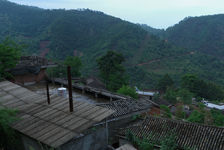
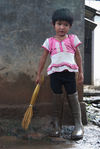
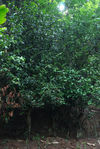
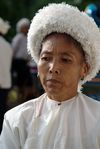
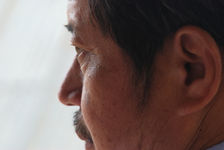
- 1.Village Da Bang Xie
- 2.A Bang Xie Today
- 3.Old tea trees Bang Xie
- 4.Female Blang Bang Xie
- 5.Producer tea Bang Xie
With the arrival of the communists in 1949 Da Bang Xie was , for its time, a very large village Blang with already more than 100 families and had radiation to the surrounding mountains. Da Bang Xie had particular one of the largest Buddhist temple in the area, unfortunately destroyed during the communist era, and rebuilt since .
Later the village of Xiao Meng Er become the central village of the village group Bang Xie, reducing the influence of Da Bang Xie, although the school was rebuilt there's little he is still at Da Bang Xie . The village remains as to what interests us , the heart of the former gardens of the mountain all those who find themselves in the small area between the three village of Bang Da Xie , Xiao Meng Er and Jio Long Zhai, the remote each other of approximately 5km .
Bang Xie , an extension of local Mengku
There are no longer any documents to accurately assess the number of tea gardens planted before 1949, but the area in the triangle Da Bang Xie , Xiao Meng Er and Jio Long Zhai was probably already before the communist era of area most rich in tea plantations in the region, with can be nearly 200 hectares of gardens. We know that in 1956 the government Shuangjiang chose the 11 villages that have the most tea plants in order to create public workshops leaves. The village group Bang Xie was when one of the first workshop, showing the importance it there's 50 years ago Xie Bang for tea in the region. Today the village of Da Bang Xie owns nearly 70 acres of gardens, of which more than half were built before 1945.
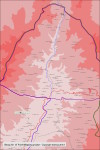
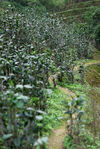
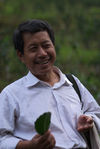
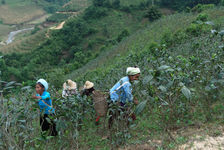
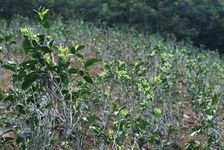
- 1.Region Bang Xie
- 2. Tea Garden in Bang Xie
- 3.Producer puerh (Pu Er tea) Bang Xie
- 4. Tea Garden in Bang Xie
- 5.Tea Garden in Bang Xie
Although Xie Bang belongs to an administrative point of view to the canton of Sha He, Xie Bang tea is considered a tea Mengku and is usually sold as such . Township Mengku indeed form a triangle in the northern region Shuangjiang . To the east and ouset Mengku is bordered by two natural boundaries , forming the valley Mengku . A West Da Xue Shan, with the famous somet Da Xue Shan rises to over 3100m , which separates Mengku but Shuangjiang the neighboring region Geng Ma To the east, the mountains Da Fen with somets has over 2600m which separate the valley Mengku and Shuangjiang region , the region of Lincang . The third edge of the triangle, between the cantons of Mengku and Shahe , is not against by a geological boundary, but an arbitrary administrative boundary , which does not reflect the reality of the land, and obviously Shahe continues southward the valley Mengku .
As the West moist Mengku ( Ban Dong Shan) Bang Xie backed the extension of the crest of Da Xue Shan, and belongs to a local perspective to Ban Dong Shan as the villages of Long Gong , Ba Ka or Bing Dao . Xie Bang teas are considered as such in Mengku and long bought and sold by vendors teas Mengku . Their quality is not only comparable to teas Mengku but teas Bang Xie doing well the flavor character of those above . They are especially known for their buds , generous and shiny , which is used often blended with other teas Mengku , but also for the particular way in which the trees are maintained , giving them a specific form of closer Bang Xie other famous villages of Mengku as Banuo .
Tradition and modernity, TenTiao Cha buds puerh (Pu Er tea)
TenTiao cha, specificity Bang Xie
The careful observer will notice the particular form taken by old teapots Bang Xie . This is Teng tiao cha (藤条 茶) , an ancient method of size tea special and typical of the region.
Qu'âgés well over 50 years , these trees do not have a very large trunk , the latter quickly separating into separate trunks , like a Tai Di ( terrace cultivation of tea) . But unlike Tai Di , the Teng Cha Tiao are not maintained in a state of bushes but reach several meters high , developing with a specific size a form entirely unique .
Trees of this size are usually what are called Qiao Mu Cha or Arbor Tea in English, based on a single trunk trees and imposing , which develop in the upper part a network branches. Instead, Teng Cha Tiao grow almost on the ground a network of long tortuous branches seeming to extend like tentacles . Each of these branches is particularly long without separating, with knots , turns on itself , takes up space , zigzags through the air towards the sky giving the tree a unique look between tree and bush .
For this we carefully scrutinizes each new shoot . The vast majority will be severed , and only a few shoots of each branch , carefully selected , will be kept , extending branch in one direction or another and giving the tree this specific look. The size of the trunk and new branches is usually accompanied by a selective pruning of leaves, many leaves are removed from the tree in order to condition the distribution of energy within the plant and the character of the young leaves .
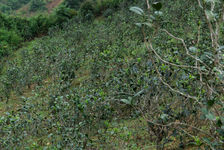
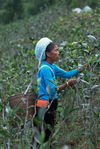
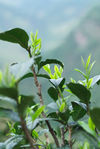
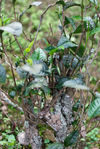
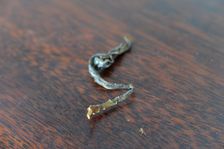
- 1.Teng Cha Tiao Xie Bang
- 2.Picking Bang Xie
- 3.Young shoots a tea Bang Xie
- 4.Young pusses after a trunk size
- 5.Horse hoof on a sheet of Teng tiao cha
The size of the tree is of course a decisive influence on the character of the tea they produce, and has contributed to the specific taste of the region. This specificity is partly the character that gives the tree size , but also the presence of fragment tender branches accompanying the tea leaves. The specific size of Teng Cha Tiao is indeed the same time as the crop , and places will cut the buds and leaves are cut required the young branch separating from the main branch . These small branches which then accompany the leaves are called My Ti , horseshoe in French , for their shape, giving the leaves a kind of shoe .
If we have more tendency to remove these My Ti when sorting , for aesthetic reasons , they are traditionally kept for their distinctive flavor character , notable not only in the early years but also through maturation tea. However, Teng Cha Tiao require more attention and work is becoming increasingly rare , gradually becoming the specificity of some villages Mengku as Banuo east Mengku , Bang Gay west Mengku or Xie Bang in Shahe township .
There's 20 years ago all the tea gardens of Bang Xie were still maintained in this way, before new and more contemporary methods requiring less work spread , like everywhere else in the region Mengku . However, and while Teng Cha Tiao disappeared here and there, they made a comeback Bang Xie, and virtually all gardens planted before 1945 are now cut so. The reason ? Focus on large buds that are now the famous Bang Xie .
disturbing enthusiasm for puerh (Pu Er tea) buds
Xie Bang , little known to the general public, is well-known professional in the area of tea and tea Bang Xie is particularly sought after for the quality to buds. Xie Bang buds are indeed especially beautiful , big , shiny and generous and are particularly popular . Each year, the arrival of the first buds of spring, producers Mengku and elsewhere flock to the village to get the best buds Bang Xie .
Rarely, if ever, only hurry , these buds will end up in assemblies of various grades , and the finest assemblers take special care to allocate these silvery buds on the surface of the wafer to refine the aesthetics that it . This is naturally the case of assemblies teas Mengku or Shuangjiang for which were chosen and finely assembles each village to the specific taste of teas they produce, but leaves and buds Bang Xie s'sarrettent not at the border of the region and are found to heart wafers from very remote area such as Xishuangbanna .
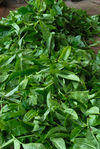
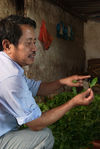
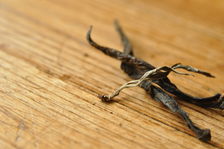
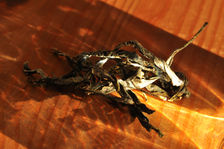
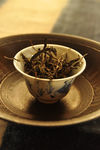
- 1.Fresh leaves Bang Xie
- 2. Bud tea with a sheet Bang Xie
- 3.Bud Dry Bang Xie Copyright Sébastien Vacuithé
- 4.Leaves and bud dry Bang Xie Copyright Sébastien Vacuithé
- 5. Maocha Bang Xie dry Copyright Sébastien Vacuithé
Indeed Lincang tea is especially fragrant ( Xiang Qi ) , and searched for it. Small proportion of these teas are often used to enhance the fragrant nature of many puerh (Pu Er tea) here and elsewhere , tea Mengku is often dubbed by professional tea " MSG puerh (Pu Er tea) " ( MSG is very common flavor enhancer in China) !
This craze for buds Bang Xie them, as we have seen a positive impact on the conservation and even the return of pruning methods of typical tea in the region. However, this trend has also dominated the bud , away from the old standards of puerh (Pu Er tea) tea, worrying amateur good puerh (Pu Er tea) . We note indeed everywhere in Yunnan, but even more in villages such as Bang Xie, a growing demand for tea consists of a high concentration of buds, as a bud for two sheets, see a bud to a sheet .
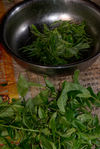
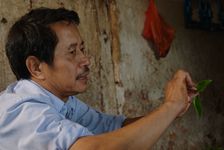
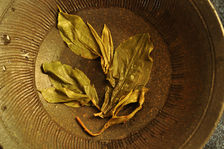
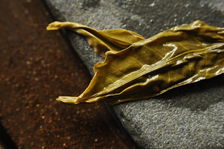
- 1.Sorting young leaves and buds to meet demnde Bang Xie
- 2.Producer focusing on large sheets trendy bud
- 3.Example maoha old- containing buds and older leaves Copyright Sébastien Vacuithé
- 4.Example sheet elderly in puerh (Pu Er tea) Copyright Sébastien Vacuithé
Such teas, inspired Wulong or green tea are popular with a new generation of producers and consumers, who see a more expensive to produce and supposedly more refined product than rarer , more aesthetic , y. However, they move away from the standard puerh (Pu Er tea) tea , which need large sheet to speak properly , but also to age properly . Meet this demand , farmers adapt and such proportion becomes more standard . And Bang Xie eg most teas produced by farmers contain a bud for two sheets, see a bud to a sheet , which threatens the typicality of puerh (Pu Er tea) area and quality over the long term .
Fortunately all small producers do not comply with market demand and some continue to produce puerh (Pu Er tea) as it was in the time. This is the case of Mr. Feng, Xie Bang capita particularly attached to the Blang culture and ancient practices that , next to puerh (Pu Er tea) more commercial based on thin film , produced annually in a small amount peurh Bang Xie the old , which is of outstanding quality and has excellent potential to mature !
And, behold, three years, what happens in the cup !
 Chargement du thé...
Chargement du thé... Chargement du thé...
Chargement du thé... Chargement du thé...
Chargement du thé...
